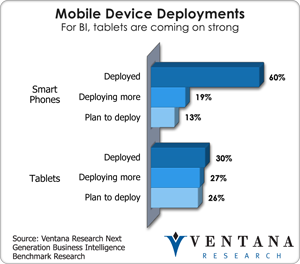We recently completed our benchmark research on next-generation business intelligence. Ventana Research looks at next-generation BI as a function of traditional BI that is converging with new technologies such as mobility, collaboration and cloud computing. Just a few years ago business intelligence might have been considered a mature category with incremental growth, but now it’s growing in new directions and it’s difficult today to call business intelligence mature.
We recently completed our benchmark research on next-generation business intelligence. Ventana Research looks at next-generation BI as a function of traditional BI that is converging with new technologies such as mobility, collaboration and cloud computing. Just a few years ago business intelligence might have been considered a mature category with incremental growth, but now it’s growing in new directions and it’s difficult today to call business intelligence mature.

From the BYOD trend, it is apparent that ease-of-use and integration expectations are being led at the consumer level. Think about how easy it is to do things on an application like Yelp, where social, local and mobile technologies come together in real time to offer insights on our choice of restaurants.
When we port these expectations into the business environment, however, the tools we have in place do not meet these expectations. In our study, only 28 percent say they are fully satisfied with mobile BI, and only 32 percent with collaborative BI. Furthermore, our maturity model shows that while the people and technology categories are mature, information and processes are immature and holding companies back with respect to next-generation BI. This makes sense, since people have the technology and are skilled at using it in consumer environments, but they lack integrated information in the workplace, as well as the processes they need to take advantage of next-generation BI capabilities. Until businesses can take advantage of the kind of integration available in the consumer environment, we will likely see the satisfaction with these technologies stay relatively low.
Unfortunately, we found no coalescence around any particular access method. Just under two-fifth of the study (38%) prefer business intelligence applications as the primary access method for collaborative BI, but 36 percent prefer access through office productivity tools, and 34 percent prefer access through applications themselves.
Clearly, next-generation business intelligence is extremely
Regards,
Tony Cosentino
VP and Research Director
